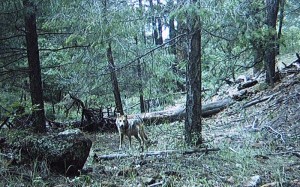Select a Location
New Mexico at a glance
 The Mexican gray wolf once roamed throughout most of New Mexico, Arizona, Texas and Mexico. Persecution and, eventually, poisoning, began shortly after European settlement. On March 29, 1998, eleven captive wolves were released into the Blue Range Wolf Recovery Area. This reintroduced population is shared by New Mexico and Arizona.
The Mexican gray wolf once roamed throughout most of New Mexico, Arizona, Texas and Mexico. Persecution and, eventually, poisoning, began shortly after European settlement. On March 29, 1998, eleven captive wolves were released into the Blue Range Wolf Recovery Area. This reintroduced population is shared by New Mexico and Arizona.
Main prey for wolves there are elk, deer and domestic livestock. Much controversy surrounds these wolves, due in large part to depredation (killing livestock) issues.
Species Information

Dark Canyon AM992 in the summer of 2010
(Photo courtesy of the Mexican Wolf Interagency Field Team.)
Species
Common Name: Mexican gray wolf, gray wolf, maicoh (Navajo), tasha (Caddo), lobo (Spanish)
Latin Name: Canis lupus
Current Wolf Population, Trend, Status
Number of wolves: 241 in a shared population with Arizona.
The 2022 population estimate represents a 23 percent increase from the minimum of 196 wolves in 2021. This marks the seventh consecutive year of population growth and a more than doubling in size since 2017. The population is distributed with 136 wolves in New Mexico and 105 in Arizona. See this article for more on that population.
Population trend: Steady/slowly growing
Legal status: Federal protection, with some exceptions
Endangered Species Reports
Mexican Wolf Interagency Field Team Quarterly Reports
Human Relationships
History
- Mexican Gray Wolf Fact Sheet, USFWS
Recovery and Management
- Mexican Wolf Recovery Program USFWS
- New Mexico Department of Game and Fish
- White Mountain Apache Tribe
- Signed agreement, cooperation marks path for Mexican wolf recovery (2018)
- Final Mexican Wolf Recovery Plan, First Revision
- Endangered Mexican gray wolf population remained flat in new count (2018)
- Mexican gray wolves count raises fears of inbreeding (2018)
- Feds release endangered wolf pups in New Mexico (2017)
Depredation
- Vimeo Video on the Mexican Gray Wolf (a layperson summary of the recent history of the wolf, its relationship to the human population, the wolf’s effect on the Rocky Mountain Elk and sheep and the practice of fladry fencing. Included are interviews with volunteers stating their purpose and perspectives as well as an interview with a representative from the Arizona Game and Fish.)
- Visit the USDA APHIS Wildlife Services site for information on how the federal government manages depredating wildlife, resolves conflict between wildlife and humans and for contact information by state.
Wolf-Human Interactions


